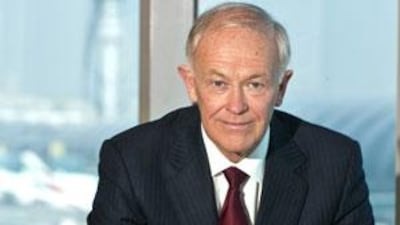Emirates Airline could delay its move from Dubai International Airport to the new Al Maktoum International Airport near Jebel Ali by as long as 10 years. Tim Clark, the president of Emirates, said the Dubai-owned airline had undergone a "rethink" and now aimed to move to the new airport between 2022 and 2030. Initially it had planned to move there between 2018 and 2020.
"We have refocused here [at Dubai International]," Mr Clark said. "With a certain amount of investment here, you can get a lot more out of this airport." Al Maktoum International is intended to attract airlines from all over the world, just as the nearby Dubai International has done for more than 50 years. But it is Emirates, with plans to add hundreds of aircraft and destinations over the coming decades, which will be the principal customer at Al Maktoum and is the main driver behind its construction.
The revised planning comes as Dubai Airports adds new infrastructure at Dubai International to boost capacity to 90 million passengers a year, up from the earlier target of 75 million. Investments include the US$1.17 billion (Dh4.29bn) Concourse 3, scheduled to open in 2012 solely to accommodate Emirates' fleet of A380 superjumbo aeroplanes. The improvements will postpone the need for Emirates and the more than 120 airlines serving Dubai to move to Al Maktoum International.
The new airport is designed as the centrepiece of a huge property project called Dubai World Central (DWC), which was originally projected to cost $33bn. Although Dubai Airports will open the first phase of Al Maktoum, at a cost of $820 million, for cargo flights this summer and passenger flights starting next year, the complex will not be able to compete for the status as the world's busiest air hub until its larger, $10bn second phase is complete.
It will comprise five runways with an annual capacity of 160 million passengers and 12 million tonnes of cargo. A completion date for this second phase has not been given. Al Maktoum International is one of several multibillion-dollar airport projects being undertaken in the region as Gulf states invest in aviation to draw in trade and tourism. Local airports rank as some of the fastest-growing hubs in the world and Dubai International last year posted a 9.2 per cent rise in passenger traffic to 40.9 million.
However, the plans have prompted the International Air Transport Association to warn of the risk of overcapacity. A spokesman for Dubai Airports said the new airport would take on a larger role as early as 2020, when demand was forecast to exceed capacity at Dubai International. "DWC has always been and continues to be a long-term project that will extend into the next decade," the spokesman said. "We forecast passenger numbers will approach 100 million by 2020. The maximum capacity at Dubai International is 90 million passengers per year."
Airport officials have said Dubai International could handle the 90 million travellers a year through improvements in runway use, passenger flows, additional manpower, and new aircraft stands and gates. Other options include an upgrade of its three terminals and the introduction of a fourth. With these changes, the Deira airport will be able to accommodate the airline's fleet growth for the next 12 years, Mr Clark said, when it would receive another 146 wide-body planes worth $49bn, on top of the 145 aircraft it now operated.
igale@thenational.ae

